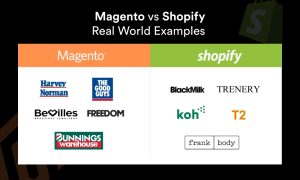
G’day, retailers! Remember when selling online meant slapping a PayPal button on a basic website and hoping for the best? Those days are long gone, mate. Today’s digital shopfronts are sophisticated beasts demanding serious thought before you commit to the tech that’ll drive your business forward.
If you’ve started researching e-commerce platforms, you’ve likely found yourself caught in the epic battle between two heavyweight contenders: Magento and Shopify. One promises ultimate freedom with a side of complexity, while the other offers simplicity with a few creative handcuffs thrown in.
For countless Aussie business owners juggling flat whites and BAS statements while trying to grow their empires, choosing between these platforms feels like deciding between a Holden and a Ford – it’s personal, consequential, and potentially divisive.
As specialists in Magento development in Sydney, we’ve seen businesses thrive and struggle on both platforms. So let’s cut through the marketing fluff and tech jargon to help you figure out which horse to back in this race.
Whether you’re a scrappy startup or an established retailer looking to level up. This no-nonsense guide will help you make a choice you won’t regret three months (and several thousand dollars) later.
What is Magento?
Ever wondered why some online stores seem to have endless features while others look like they came from a template? Meet the powerhouse behind those custom giants: Adobe Commerce (formerly Magento).
Born in 2008 and adopted by Adobe a decade later, Magento is the Ferrari of e-commerce platforms – high-performance, highly customizable, and yes, with a price tag to match. It’s the platform that lets you build virtually anything you can imagine.
As an open-source platform, Magento is like getting the keys to the factory, not just the car. Australian retailers with complex catalogs or ambitious growth plans gravitate toward Magento because it is strong enough to handle thousands of products, multiple storefronts, and intricate B2B relationships.
But fair warning, mate – this isn’t a plug-and-play solution. The same power that makes Magento brilliant also makes it complex. Think of it as owning a thoroughbred racehorse instead of a family pony – magnificent capabilities, but requires expert handling and care.
What is Shopify?
Picture this: You’re keen to start selling online by the weekend. Sound impossible? Not with Shopify.
This Canadian-born platform has become the friendly neighborhood superhero of e-commerce since 2006, powering over a million businesses worldwide with its “no tech degree required” approach.
Unlike its more complex competitors, Shopify bundles everything you need into one neat package – hosting, security, payments, the works! It’s the digital equivalent of a turnkey business, making it the darling of startups, creative entrepreneurs, and anyone who’d rather focus on selling than server management.
The magic of Shopify lies in its dashboard that even your tech-phobic uncle could navigate. Need a specific function? There’s probably an app for that among the thousands available. Sure, each fancy add-on might cost you a monthly subscription, but that’s the trade-off for simplicity.
While you won’t be building the next Amazon-level custom experience on Shopify, it offers enough flexibility for most online retailers who value getting to market quickly over having every bell and whistle customized to perfection.
Magento vs Shopify: Feature-by-Feature Comparison
Let’s cut to the chase. Your business deserves cold, hard facts when choosing an e-commerce platform. This definitive comparison lays bare exactly what you’ll get with each option – no fluff, just the decisive details you need to make your move.
| Feature | Magento | Shopify |
| Ease of Use | Steeper learning curve with complex admin panel; requires technical expertise. | User-friendly interface; beginners can set up stores within hours; intuitive control panel. |
| Customisation & Flexibility | Unlimited customisation with open-source architecture; complete control over design, features, and checkout processes. | Good customisation within the template framework; theme modifications and apps provide unique looks and functionality. |
| SEO & Marketing Tools | Granular control over all SEO aspects; fully customisable URL structures, meta information, and more. | User-friendly built-in SEO tools; automatic sitemaps, canonical tags, and robots.txt files. |
| Payment Gateways & Fees | No platform transaction charges regardless of payment gateway; can integrate any payment provider. | Built-in support for 100+ payment providers, including Australian favorites (Afterpay, Zip Pay); additional transaction fees for external payment gateways. |
| Scalability & Performance | Superior scalability; handles 100,000+ SKUs and high traffic without performance degradation. | Good for small to medium-sized stores; may struggle with extremely high traffic or complex requirements. |
| Developer Support & Community | Extensive global developer and partner network; specialized agencies for the Australian market. | Excellent official support and documentation; growing network of service providers. |
| Initial Setup Cost | Open Source: Free download<br>Adobe Commerce: Starting ~$22,000 annually. | No upfront license fees |
| Hosting | Self-hosted: $30-500+ monthly depending on traffic/needs. | Included in the subscription. |
Which Platform Is Best for Your Business?
Our ideal platform relies mainly on your business model, resources, and growth potential:
Consider Magento if:
- You have to have a great deal of customisation for specific business processes.
- Your product catalogue is over several thousand items or has complicated attributes.
- You are planning for a massive expansion or an international expansion.
- There is a need for your business model to have unique pricing structures or checkout processes.
- Whether you are a B2B seller or have complicated wholesale/retail needs.
Consider Shopify if:
- You have to get in with affordable technical means.
- Your needs align with ordinary e-commerce capabilities
- Your business is small or medium-sized, dealing with simple products.
- You do not have technical staff and desire easy management.
- You’re at ease with Shopify services for the first configuration and simple customisations.
Several Australian fashion boutiques, craft businesses, and niche retailers find Shopify’s straightforward approach ideal.
Real-World Brand Examples

Magento Magic Down Under
Crikey! Some of Australia’s biggest retail players are backing Magento to power their digital storefronts. Take a gander at Harvey Norman and The Good Guys, who rely on Magento’s grunt to handle their massive product ranges and complex specifications. Then there’s Bevilles Jewellers and Bunnings Warehouse, using the platform’s muscle to create those seamless shopping experiences we’ve all enjoyed while grabbing bling or Bunnings snags.
Even Freedom Furniture has jumped on the Magento bandwagon to showcase its extensive homewares collection. It’s no wonder these retail heavyweights choose Magento – when you’re shifting thousands of products across multiple categories with all sorts of fancy features, you need a platform that won’t crack under pressure.
Shopify Stars of the Southern Cross
On the flipside, some of our most loved Aussie brands are smashing it with Shopify. Who’s Pear Activewear and Trenery are killing it in the fashion game, while the legends at Black Milk Clothing use Shopify to sling their quirky threads to fans worldwide. Fancy a cuppa? T2 Tea ditched their old setup for Shopify’s streamlined approach. Even Frank Body went from startup sensation to global skincare superstar, with Shopify handling the heavy lifting behind their cheeky brand voice.
And let’s not forget local heroes like Flora & Fauna and Koh cleaning products, who’ve built cult followings without needing a team of tech gurus on speed dial. These success stories show that with the right products and marketing, Shopify’s simplicity doesn’t mean sacrificing serious success.
🎧 Podcast: Magento vs Shopify – E-Commerce Face-Off for Aussie Retailers

Not keen on reading through all the details? Prefer to listen on the go? Tune into our latest episode where we unpack Magento vs Shopify in plain English — no jargon, just real talk tailored for Australian businesses.
Time to Place Your Bets
Let’s be honest – you didn’t read this far to hear “it depends” (though it does). You want someone to tell you which platform to back so you can get on with the business of actually selling stuff.
Here’s the straight talk: If your business model looks like a tangled web of custom pricing, complex inventory, and unique customer journeys, Magento’s your mate. Sure, it’ll cost you more upfront and require Shopify development services levels of expertise to set up, but it won’t hold you back when you’re ready to go big.
On the flip side, if you’re keen to start selling yesterday, don’t have a tech team on speed dial, and your business model isn’t reinventing the wheel, Shopify’s ready to party. It might cost you more in subscription fees over time, but you’ll sleep better knowing someone else is handling the technical gremlins.
Whatever you choose, remember that the platform is just the canvas – your products, marketing, and customer service are what create the masterpiece. So pick your poison, commit to it fully, and focus on what truly matters: building a ripper of an online store that keeps customers coming back for more.
And hey, if you’re still stuck between these two digital dance partners, why not shout a local expert a coffee? Sometimes the best business decisions happen over a flat white rather than a flat screen.
Need expert help choosing between Magento and Shopify? Contact our experienced Magento and Shopify development team today for a free consultation.


